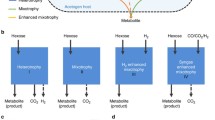Abstract
The hyperthermophilic archaeon, Thermococcus onnurineus, was grown in media supplemented with either CO, formate, or starch. H2 was produced with each substrate with respective maximum rates of 1.55, 3.83 and 2.66 mmol H2/l h. The yields (mol H2/mol substrate) were 0.98, 1 and 3.13, respectively. This microbe is the first example where a single microorganism can grow and produce H2 using CO, formate or starch as substrate.

Similar content being viewed by others
References
Bae SS, Kim YJ, Yang SH, Lim JK et al (2006) Thermococcus onnurineus sp. nov., a hyperthermophilic archaeon isolated from a deep-sea hydrothermal vent area at the PACMANUS field. J Microbiol Biotechnol 16:1826–1831
Balch WE, Wolfe RS (1976) New approach to the cultivation of methanogenic bacteria: 2-mercaptoethanesulfonic acid (HS-CoM)-dependent growth of Methanobacterium ruminantium in a pressureized atmosphere. Appl Environ Microbiol 32:781–791
Chou CJ, Jenney FE, Adams MWW, Kelly RM (2008) Hydrogenesis in hyperthermophilic microorganisms: implications for biofuels. Metab Eng 10:394–404
Claassen PAM, Van Lier JB, Lopez Contreras AM et al (1999) Utilisation of biomass for the supply of energy carriers. Appl Microbiol Biotechnol 52:741–755
Das D, Veziroglu TN (2001) Hydrogen production by biological processes: a survey of literature. Int J Hydrogen Energ 26:13–28
Holden JF, Takai K, Summit M, Bolton S, Zyskowski J, Baross JA (2001) Diversity among three novel groups of hyperthermophilic deep-sea Thermococcus species from three sites in the northeastern Pacific Ocean. FEMS Microbiol Ecol 36:51–60
Kadar Z, De Vrije T, Van Noorden GE et al (2004) Yields from glucose, xylose, and paper sludge hydrolysate during hydrogen production by the extreme thermophile Caldicellulosiruptor saccharolyticus. Appl Biochem Biotechnol 114:497–508
Kanai T, Imanaka H, Nakajima A, Uwamori K et al (2005) Continuous hydrogen production by the hyperthermophilic archaeon, Thermococcus kodakaraensis KOD1. J Biotechnol 116:271–282
Kim YJ, Lee HS, Kim ES, Bae SS, Lim JK et al (2010) Formate-driven growth coupled with H2 production. Nature 467:352–355
Lee HS, Kang SG, Bae SS, Lim JK et al (2008) The complete genome sequence of Thermococcus onnurineus NA1 reveals a mixed heterotrophic and carboxydotrophic metabolism. J Bacteriol 190:7491–7499
Lim JK, Kang SG, Lebedinsky AV, Lee JH, Lee HS (2010) Identification of a novel class of membrane-bound [NiFe]-hydrogenases in Thermococcus onnurineus NA1 by in silico analysis. Appl Environ Microbiol 76:6286–6289
Nath K, Das D (2004) Improvement of fermentative hydrogen production: various approaches. Appl Microbiol Biotechnol 65:520–529
Porter KG, Feig YS (1980) The use of DAPI for identifying and counting aquatic microflora. Limnol Oceanogr 25:943–948
Sapra R, Bagramyan K, Adams MW (2003) A simple energy-conserving system: proton reduction coupled to proton translocation. Proc Natl Acad Sci 100:7545–7550
Schicho RN, Ma K, Adams MW, Kelly RM (1993) Bioenergetics of sulfur reduction in the hyperthermophilic archaeon Pyrococcus furiosus. J Bacteriol 175:1823–1830
Sokolova TG, Jeanthon C, Kostrikina NA, Chernyh NA et al (2004) The first evidence of anaerobic CO oxidation coupled with H2 production by a hyperthermophilic archaeon isolated from a deep-sea hydrothermal vent. Extremophiles 8:317–323
Thauer RK, Jungermann K, Decker K (1977) Energy conservation in chemotrophic anaerobic bacteria. Microbiol Mol Biol Rev 41:100–180
Valdez-Vazquez I, Poggi-Varaldo HM (2009) Hydrogen production by fermentative consortia. Renewable Sustainable Energy Rev 13:1000–1013
Verhagen MF, Adams MW (2001) Fe-only hydrogenase from Thermotoga maritima. Methods Enzymol 331:216–226
Woodward J, Orr M, Cordray K, Greenbaum E (2000) Biotechnology: enzymatic production of biohydrogen. Nature 405:1014–1015
Acknowledgments
This work was supported by the Marine and Extreme Genome Research Centre and the Development of Biohydrogen Production Technology using the Hyperthermophilic Archaea program of the Ministry of Land, Transport, and Maritime Affairs in the Republic of South Korea.
Author information
Authors and Affiliations
Corresponding author
Additional information
Seung Seob Bae and Tae Wan Kim equally contributed to this article.
Rights and permissions
About this article
Cite this article
Bae, S.S., Kim, T.W., Lee, H.S. et al. H2 production from CO, formate or starch using the hyperthermophilic archaeon, Thermococcus onnurineus . Biotechnol Lett 34, 75–79 (2012). https://doi.org/10.1007/s10529-011-0732-3
Received:
Accepted:
Published:
Issue Date:
DOI: https://doi.org/10.1007/s10529-011-0732-3




